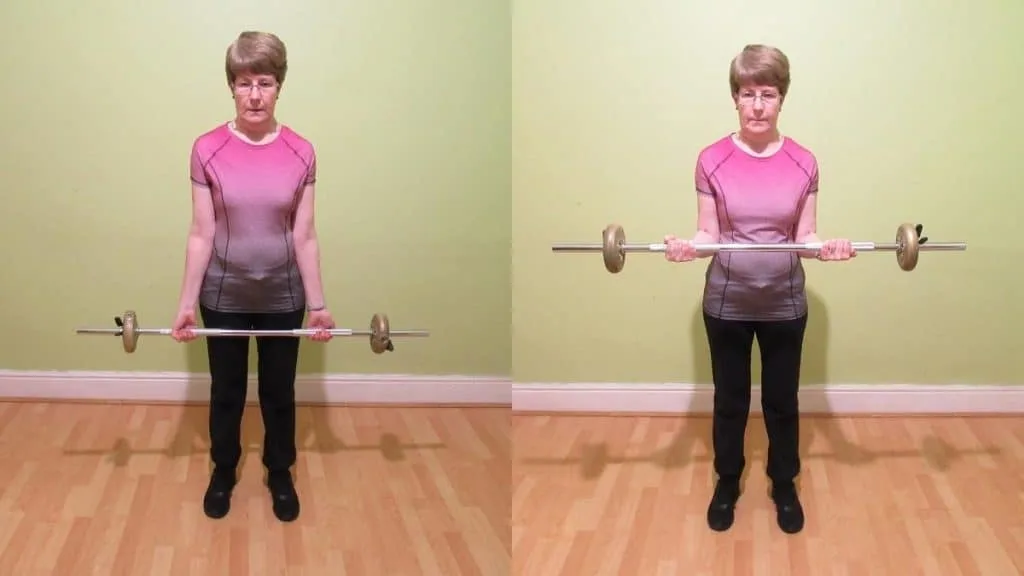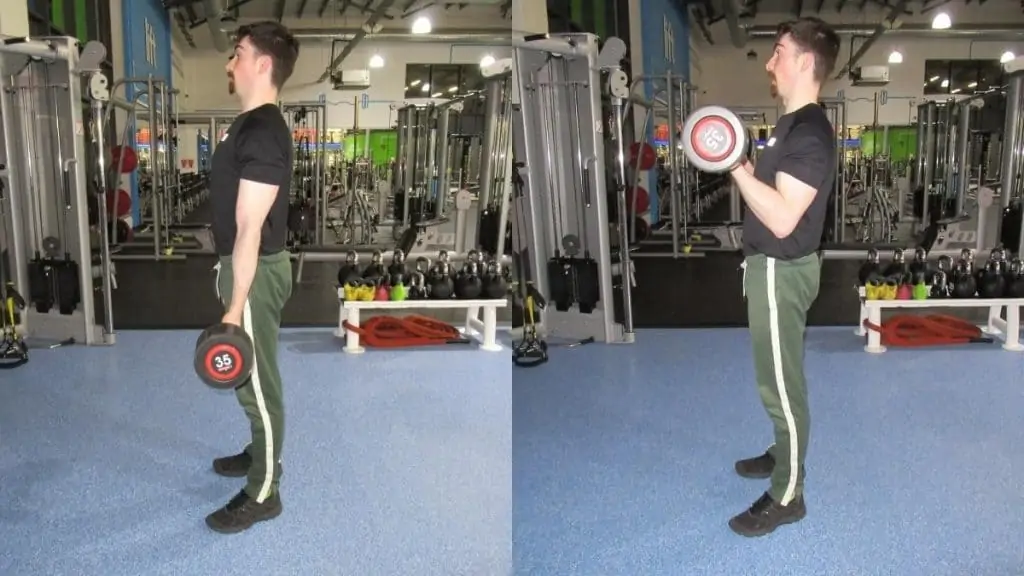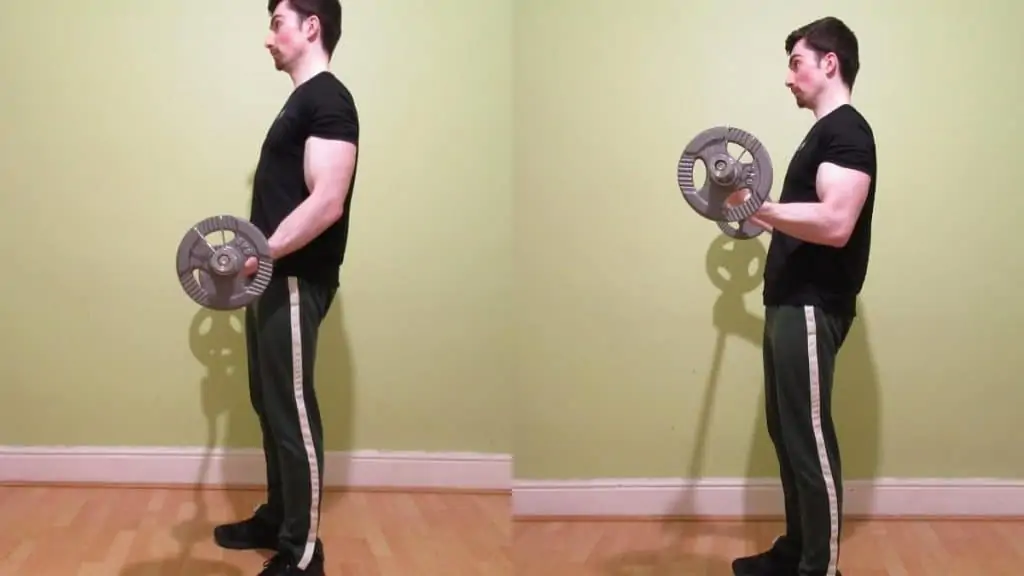How much should I be able to curl based on my height, weight, and gender?
That’s a question that we hear all the time. The truth is that bicep curl standards depend on whether you’re curling a dumbbell or a barbell and whether you’re performing multiple reps or trying to set a new bicep curl max.
With that in mind, this biceps guide breaks down the average curl weight by gender and then explains how much weight you should curl with barbells and dumbbells.
Related Guides: Dumbbell bicep curls│Barbell bicep curl
How much can the average man curl?

How much can the average man curl with his biceps?
The average barbell curl weight for a man with a few years of lifting experience is around 110 lbs for a max bicep curl. For reps, 80 lbs is a good weight to curl for a man who performs direct arm training.
How much can the average man dumbbell curl?
The average dumbbell curl weight for a man who performs resistance training regularly is 50 lbs for a max curl or for a few reps. For sets of 8-10 reps, the average dumbbell curl weight for a male lifter is around 35 lbs.
Of course, these dumbbell and barbell curl standards will go up or down based on your body weight and the size of your biceps.
How much should I be able to curl as a woman?

How much weight should I curl with a barbell as a woman?
A good bicep curl weight for a woman who performs strength training is 50 lbs for a one-rep max. For sets of 6-10 reps, 40 lbs is a good curling weight providing that strict form is used.
How much weight should I curl with a dumbbell as a female?
The average bicep curl weight (dumbbell) for a female is around 25 lbs to 30 lbs for a max curl and 15 lbs to 20 lbs for sets of 6-10 repetitions.
As mentioned, bicep curl strength standards heavily depend on your body weight, so don’t be alarmed if you fall outside of these estimates.
What is the average bicep curl weight in kilograms (KG)?

The average bicep curl weight in kilograms is 50 kg (barbell) and 22.5 kg (dumbbell). These male bicep curl standards are one-rep max lifts.
For 6-10 reps, most men should be able to curl around 35 kg with a barbell and 15 kg with dumbbells.
The average curl weight in kilograms for a woman is 22.5 kg (barbell) and 13 kg for a dumbbell. These are both one-rep max lifts based on the strength of the average weight lifting woman.
For sets of 6-10 reps, most female lifters can usually bicep curl 10 kg to 12 kg with a barbell and 5kg to 9 kg with dumbbells.
You can also check out these guides to see how impressive your max curl weight is.
- 10 kg bicep curl
- 20 kg bicep curl
- 30 kg bicep curl
- 40 kg bicep curl
- 50 kg bicep curl
- 60 kg bicep curl
- 70 kg bicep curl
- 100 kg bicep curl
How much weight should I use for bicep curls?

What weight should I use for bicep curls?
The ideal weight to use for bicep curls depends on your goals. If you want to make your biceps bigger, then your best bet is to pick a weight that will allow you to perform sets of 8-12 reps.
This is because moderate reps enable you to accumulate plenty of training volume in a relatively short space of time. [1]
On the other hand, if increasing your bicep strength is your number one priority, then you should perform sets of 5-7 reps most of the time (even lower for compound movements). [2]
Additionally, you should curl barbells primarily since they enable you to lift heavier weights than dumbbells.
If hypertrophy is indeed your primary goal, however, then you should also mix dumbbells and barbells. Curling barbells (whether that’s an Olympic bar or an EZ bar) will enable you to overload your biceps with plenty of resistance.
Conversely, lifting dumbbells enables you to supinate your wrists to a higher degree, which in turn provides a stronger peak contraction in your biceps.
Average curl weight case studies

How much can you curl? How does your strength stack up against the average dumbbell weight?
If you want to know how your current strength (for reps or a one-rep max) stacks up against the current bicep curl standards, you can check out these guides to see how hard it is to curl a given weight with both barbells and dumbbell.
- 10 lb curls
- 15 lb bicep curl
- 20 lb curls
- 25 lb bicep curl
- 30 lb curls
- 40 lb dumbbell curls
- 45 lb dumbbell curl
- 50 lb dumbbell curls
- 60 lb curl
- 70 lb dumbbell curls
- 80 lb dumbbell curl
- 90 lb bicep curl
- 100 lb curl
- 135 lb curl
- 150 lb bicep curl
- 200 lb curl
- 300 lb curl
Why is there no bicep curl weight chart?
While it’s true that lifters with higher body weights can usually curl heavier barbells and dumbbells than those with lower body weights, that’s only true because having extra body mass often also means that you have more biceps mass.
In theory, however, it’s entirely possible that you could weigh considerably less than your friends while still having much bigger and stronger biceps.
This is because hypertrophy is a local process. [3] In other words, curling heavy weights is a great way to build your biceps but virtually useless for developing your triceps or chest muscles.
So whenever you see a bicep curl weight chart, you should be very skeptical of its accuracy. Extra body mass only makes your biceps stronger if it actually increases the muscularity of your biceps and forearms.
You can also see our bicep curl world record guide if you want proof that body weight is not the main determinant of curling strength.
Conclusion: What is a good weight to curl?

Strength is a combination of muscle size and skill. However, since the bicep curl is a fairly easy lift to learn and master, the main determinant of your bicep curl strength is the size of your biceps muscles, something which often correlates with body weight among weight lifters.
With that in mind, the average curl weight for men who lift regularly is typically around 110 lbs (bar) and 50 lbs (dumbbells).
For a woman who trains her arms, a good bicep curl weight is 50 lbs (bar) and 25 lbs (dumbbells).
If you fall below these numbers, then the best way to increase your strength is with direct bicep training.
Increasing your body weight can also help because it involves eating in a calorie surplus, which in turn gives your body extra energy that it can use to grow new muscle mass.
References
- Nuckols, G. (2021, September 13). The “Hypertrophy Rep Range” – Fact or Fiction? Stronger by Science. https://www.strongerbyscience.com/hypertrophy-range-fact-fiction/
- Schoenfeld, B. J., Contreras, B., Vigotsky, A. D., & Peterson, M. (1995). Differential Effects of Heavy Versus Moderate Loads on Measures of Strength and Hypertrophy in Resistance-Trained Men. Journal of Sports Science and Medicine, 15(4), 715–722. https://www.ncbi.nlm.nih.gov/pmc/articles/PMC5131226/
- West, D. W., Burd, N. A., Staples, A. W., & Phillips, S. M. (2010). Human exercise-mediated skeletal muscle hypertrophy is an intrinsic process. The International Journal of Biochemistry & Cell Biology, 42(9), 1371–1375. https://doi.org/10.1016/j.biocel.2010.05.012

